Community Health Assessment Plan on Diabetes: King County, USA
VerifiedAdded on 2022/08/23
|6
|1372
|23
Report
AI Summary
This report presents a community health assessment plan focused on diabetes within the King County community, highlighting the health disparities faced by African Americans. It outlines the involvement of key stakeholders such as primary care providers, nurses, endocrinologists, and dietitians, detailing their roles and responsibilities in monitoring and managing diabetic patients. The plan aims to reduce diabetes prevalence and prevent associated illnesses, addressing issues like lack of health insurance and unequal access to care. Data collection methods include primary and secondary sources, utilizing surveys, questionnaires, and government databases. The report concludes by emphasizing the importance of implementing this assessment plan to improve community health outcomes through a collaborative approach involving various healthcare professionals and data-driven strategies. The assignment provides a comprehensive overview of the assessment plan, covering the stakeholders' roles, data collection methods, and the plan's goals.
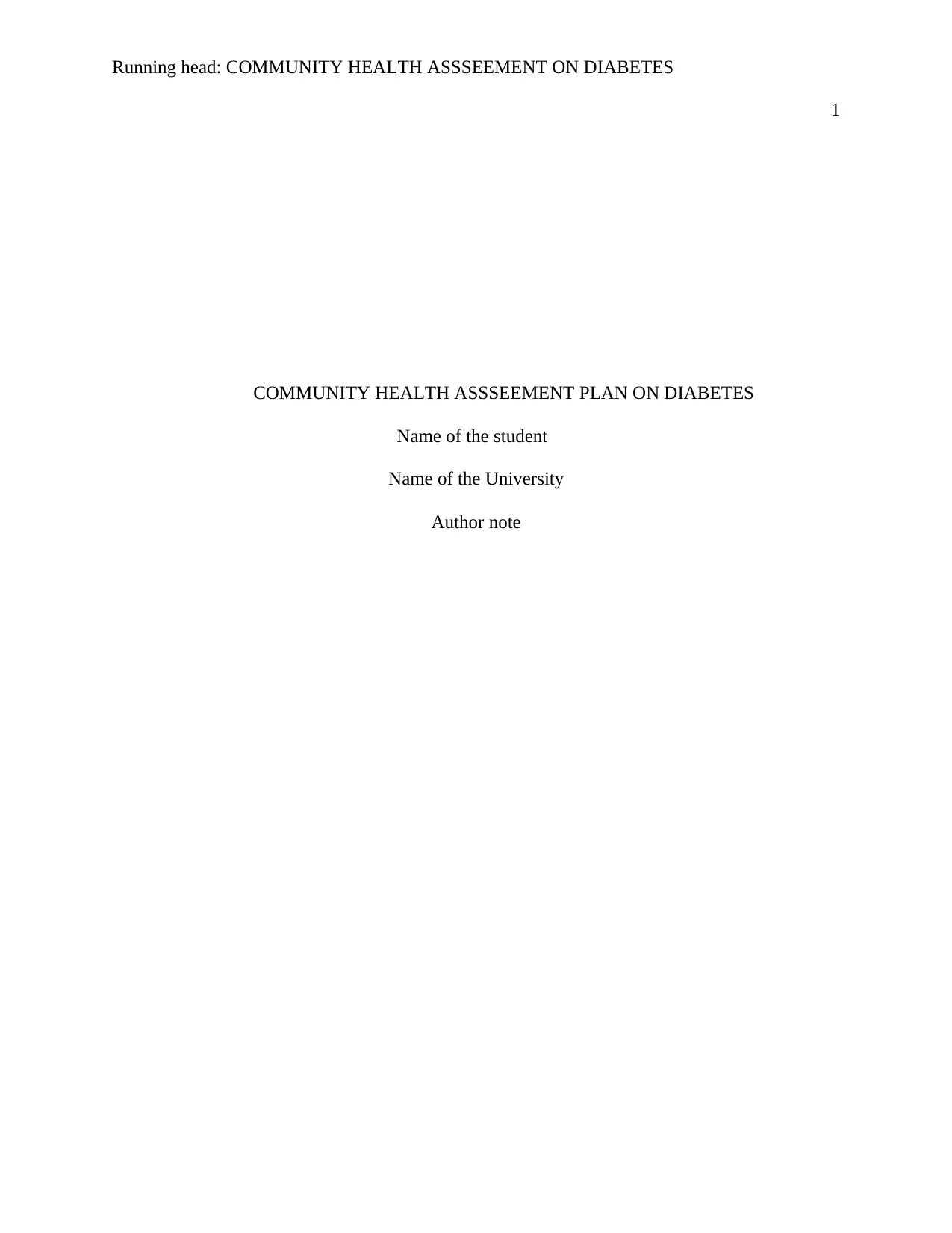
Running head: COMMUNITY HEALTH ASSSEEMENT ON DIABETES
1
COMMUNITY HEALTH ASSSEEMENT PLAN ON DIABETES
Name of the student
Name of the University
Author note
1
COMMUNITY HEALTH ASSSEEMENT PLAN ON DIABETES
Name of the student
Name of the University
Author note
Paraphrase This Document
Need a fresh take? Get an instant paraphrase of this document with our AI Paraphraser
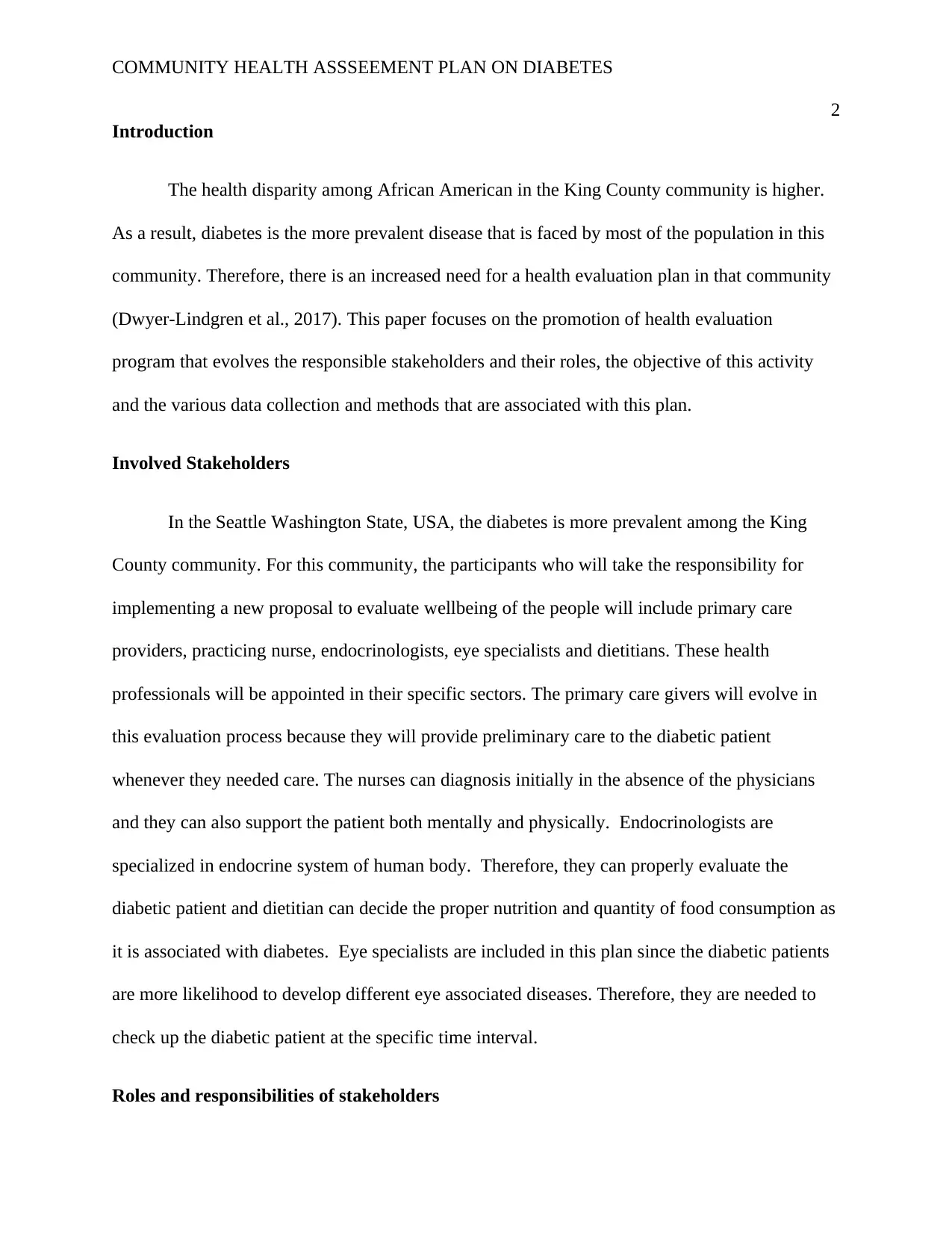
COMMUNITY HEALTH ASSSEEMENT PLAN ON DIABETES
2
Introduction
The health disparity among African American in the King County community is higher.
As a result, diabetes is the more prevalent disease that is faced by most of the population in this
community. Therefore, there is an increased need for a health evaluation plan in that community
(Dwyer-Lindgren et al., 2017). This paper focuses on the promotion of health evaluation
program that evolves the responsible stakeholders and their roles, the objective of this activity
and the various data collection and methods that are associated with this plan.
Involved Stakeholders
In the Seattle Washington State, USA, the diabetes is more prevalent among the King
County community. For this community, the participants who will take the responsibility for
implementing a new proposal to evaluate wellbeing of the people will include primary care
providers, practicing nurse, endocrinologists, eye specialists and dietitians. These health
professionals will be appointed in their specific sectors. The primary care givers will evolve in
this evaluation process because they will provide preliminary care to the diabetic patient
whenever they needed care. The nurses can diagnosis initially in the absence of the physicians
and they can also support the patient both mentally and physically. Endocrinologists are
specialized in endocrine system of human body. Therefore, they can properly evaluate the
diabetic patient and dietitian can decide the proper nutrition and quantity of food consumption as
it is associated with diabetes. Eye specialists are included in this plan since the diabetic patients
are more likelihood to develop different eye associated diseases. Therefore, they are needed to
check up the diabetic patient at the specific time interval.
Roles and responsibilities of stakeholders
2
Introduction
The health disparity among African American in the King County community is higher.
As a result, diabetes is the more prevalent disease that is faced by most of the population in this
community. Therefore, there is an increased need for a health evaluation plan in that community
(Dwyer-Lindgren et al., 2017). This paper focuses on the promotion of health evaluation
program that evolves the responsible stakeholders and their roles, the objective of this activity
and the various data collection and methods that are associated with this plan.
Involved Stakeholders
In the Seattle Washington State, USA, the diabetes is more prevalent among the King
County community. For this community, the participants who will take the responsibility for
implementing a new proposal to evaluate wellbeing of the people will include primary care
providers, practicing nurse, endocrinologists, eye specialists and dietitians. These health
professionals will be appointed in their specific sectors. The primary care givers will evolve in
this evaluation process because they will provide preliminary care to the diabetic patient
whenever they needed care. The nurses can diagnosis initially in the absence of the physicians
and they can also support the patient both mentally and physically. Endocrinologists are
specialized in endocrine system of human body. Therefore, they can properly evaluate the
diabetic patient and dietitian can decide the proper nutrition and quantity of food consumption as
it is associated with diabetes. Eye specialists are included in this plan since the diabetic patients
are more likelihood to develop different eye associated diseases. Therefore, they are needed to
check up the diabetic patient at the specific time interval.
Roles and responsibilities of stakeholders
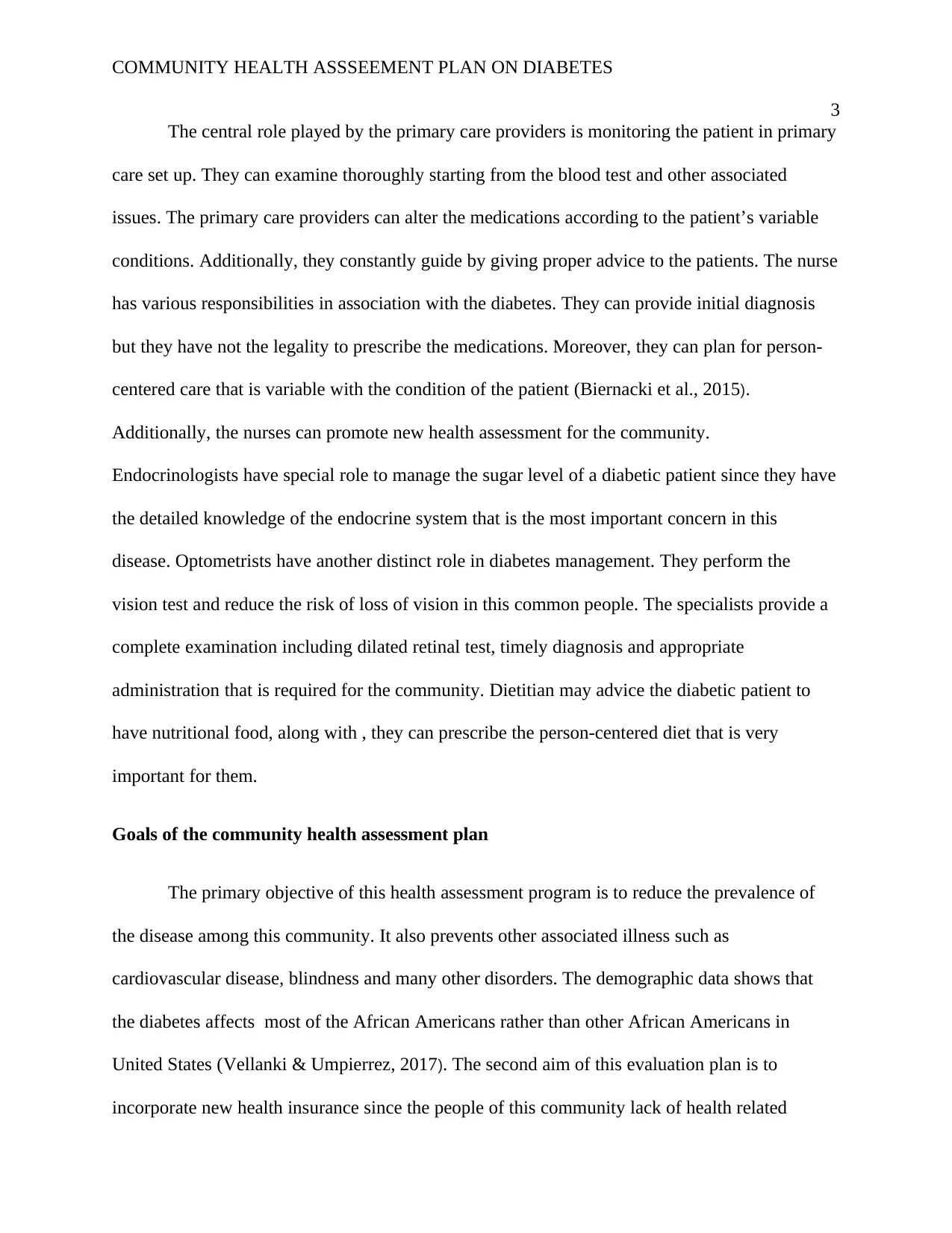
COMMUNITY HEALTH ASSSEEMENT PLAN ON DIABETES
3
The central role played by the primary care providers is monitoring the patient in primary
care set up. They can examine thoroughly starting from the blood test and other associated
issues. The primary care providers can alter the medications according to the patient’s variable
conditions. Additionally, they constantly guide by giving proper advice to the patients. The nurse
has various responsibilities in association with the diabetes. They can provide initial diagnosis
but they have not the legality to prescribe the medications. Moreover, they can plan for person-
centered care that is variable with the condition of the patient (Biernacki et al., 2015).
Additionally, the nurses can promote new health assessment for the community.
Endocrinologists have special role to manage the sugar level of a diabetic patient since they have
the detailed knowledge of the endocrine system that is the most important concern in this
disease. Optometrists have another distinct role in diabetes management. They perform the
vision test and reduce the risk of loss of vision in this common people. The specialists provide a
complete examination including dilated retinal test, timely diagnosis and appropriate
administration that is required for the community. Dietitian may advice the diabetic patient to
have nutritional food, along with , they can prescribe the person-centered diet that is very
important for them.
Goals of the community health assessment plan
The primary objective of this health assessment program is to reduce the prevalence of
the disease among this community. It also prevents other associated illness such as
cardiovascular disease, blindness and many other disorders. The demographic data shows that
the diabetes affects most of the African Americans rather than other African Americans in
United States (Vellanki & Umpierrez, 2017). The second aim of this evaluation plan is to
incorporate new health insurance since the people of this community lack of health related
3
The central role played by the primary care providers is monitoring the patient in primary
care set up. They can examine thoroughly starting from the blood test and other associated
issues. The primary care providers can alter the medications according to the patient’s variable
conditions. Additionally, they constantly guide by giving proper advice to the patients. The nurse
has various responsibilities in association with the diabetes. They can provide initial diagnosis
but they have not the legality to prescribe the medications. Moreover, they can plan for person-
centered care that is variable with the condition of the patient (Biernacki et al., 2015).
Additionally, the nurses can promote new health assessment for the community.
Endocrinologists have special role to manage the sugar level of a diabetic patient since they have
the detailed knowledge of the endocrine system that is the most important concern in this
disease. Optometrists have another distinct role in diabetes management. They perform the
vision test and reduce the risk of loss of vision in this common people. The specialists provide a
complete examination including dilated retinal test, timely diagnosis and appropriate
administration that is required for the community. Dietitian may advice the diabetic patient to
have nutritional food, along with , they can prescribe the person-centered diet that is very
important for them.
Goals of the community health assessment plan
The primary objective of this health assessment program is to reduce the prevalence of
the disease among this community. It also prevents other associated illness such as
cardiovascular disease, blindness and many other disorders. The demographic data shows that
the diabetes affects most of the African Americans rather than other African Americans in
United States (Vellanki & Umpierrez, 2017). The second aim of this evaluation plan is to
incorporate new health insurance since the people of this community lack of health related
⊘ This is a preview!⊘
Do you want full access?
Subscribe today to unlock all pages.

Trusted by 1+ million students worldwide
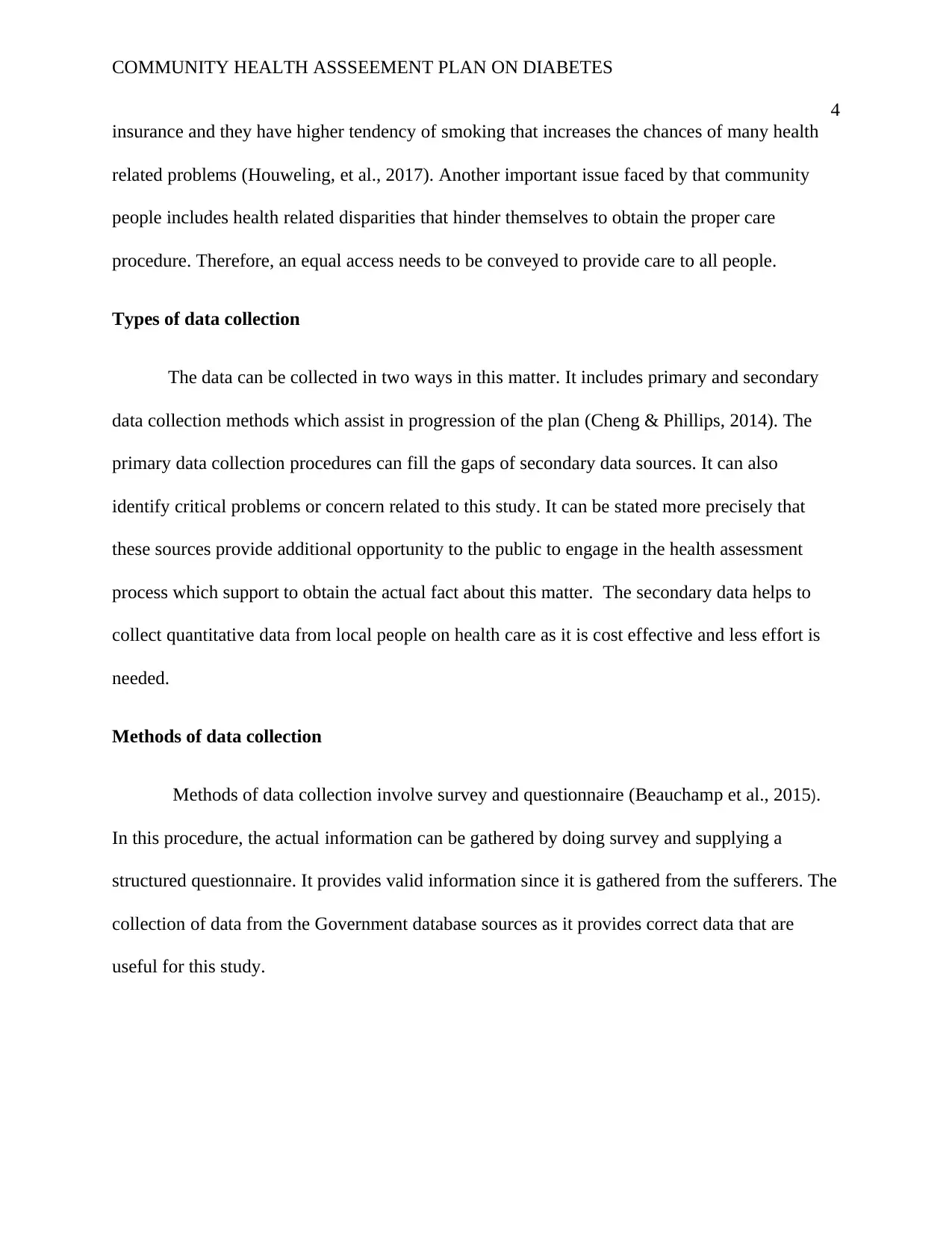
COMMUNITY HEALTH ASSSEEMENT PLAN ON DIABETES
4
insurance and they have higher tendency of smoking that increases the chances of many health
related problems (Houweling, et al., 2017). Another important issue faced by that community
people includes health related disparities that hinder themselves to obtain the proper care
procedure. Therefore, an equal access needs to be conveyed to provide care to all people.
Types of data collection
The data can be collected in two ways in this matter. It includes primary and secondary
data collection methods which assist in progression of the plan (Cheng & Phillips, 2014). The
primary data collection procedures can fill the gaps of secondary data sources. It can also
identify critical problems or concern related to this study. It can be stated more precisely that
these sources provide additional opportunity to the public to engage in the health assessment
process which support to obtain the actual fact about this matter. The secondary data helps to
collect quantitative data from local people on health care as it is cost effective and less effort is
needed.
Methods of data collection
Methods of data collection involve survey and questionnaire (Beauchamp et al., 2015).
In this procedure, the actual information can be gathered by doing survey and supplying a
structured questionnaire. It provides valid information since it is gathered from the sufferers. The
collection of data from the Government database sources as it provides correct data that are
useful for this study.
4
insurance and they have higher tendency of smoking that increases the chances of many health
related problems (Houweling, et al., 2017). Another important issue faced by that community
people includes health related disparities that hinder themselves to obtain the proper care
procedure. Therefore, an equal access needs to be conveyed to provide care to all people.
Types of data collection
The data can be collected in two ways in this matter. It includes primary and secondary
data collection methods which assist in progression of the plan (Cheng & Phillips, 2014). The
primary data collection procedures can fill the gaps of secondary data sources. It can also
identify critical problems or concern related to this study. It can be stated more precisely that
these sources provide additional opportunity to the public to engage in the health assessment
process which support to obtain the actual fact about this matter. The secondary data helps to
collect quantitative data from local people on health care as it is cost effective and less effort is
needed.
Methods of data collection
Methods of data collection involve survey and questionnaire (Beauchamp et al., 2015).
In this procedure, the actual information can be gathered by doing survey and supplying a
structured questionnaire. It provides valid information since it is gathered from the sufferers. The
collection of data from the Government database sources as it provides correct data that are
useful for this study.
Paraphrase This Document
Need a fresh take? Get an instant paraphrase of this document with our AI Paraphraser
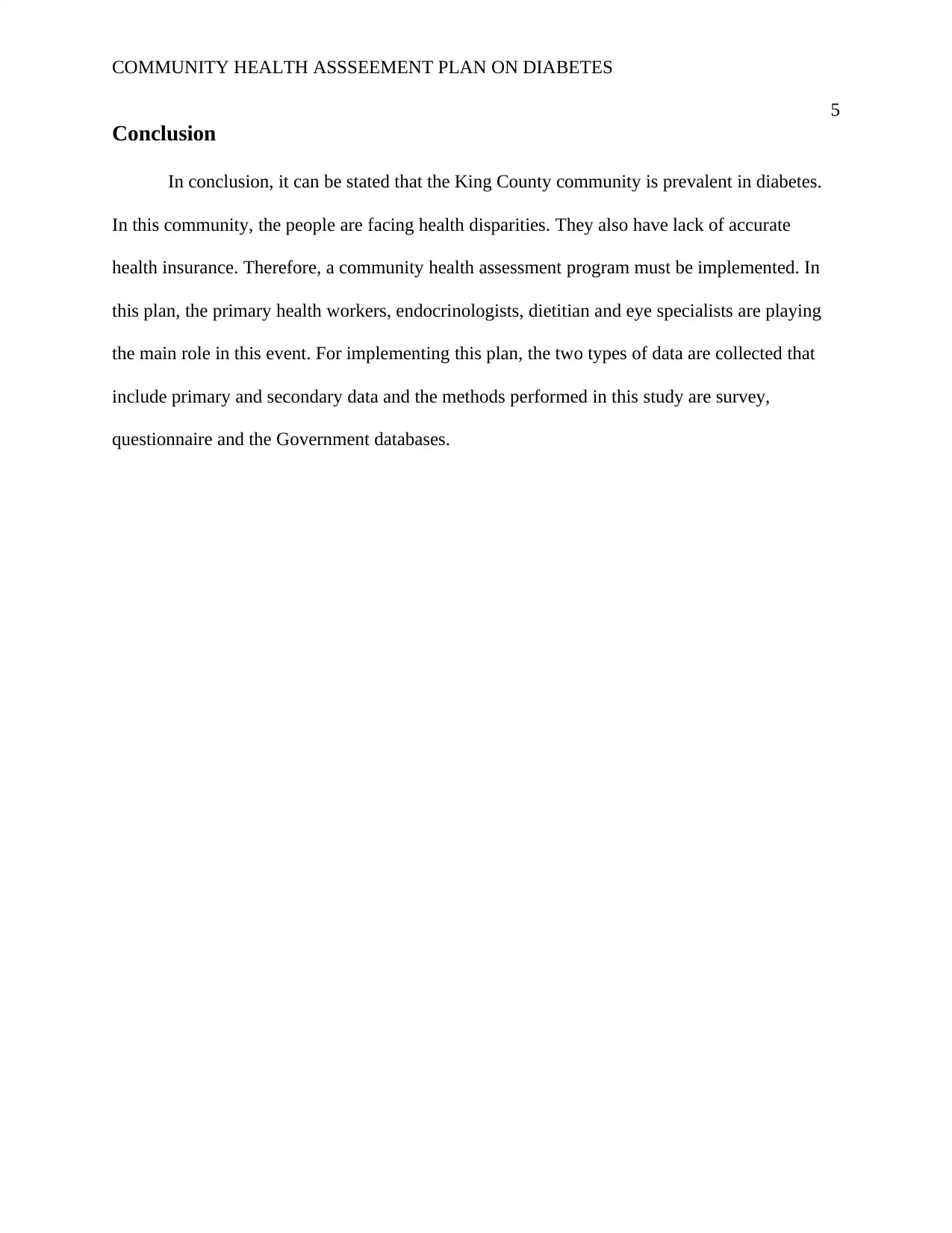
COMMUNITY HEALTH ASSSEEMENT PLAN ON DIABETES
5
Conclusion
In conclusion, it can be stated that the King County community is prevalent in diabetes.
In this community, the people are facing health disparities. They also have lack of accurate
health insurance. Therefore, a community health assessment program must be implemented. In
this plan, the primary health workers, endocrinologists, dietitian and eye specialists are playing
the main role in this event. For implementing this plan, the two types of data are collected that
include primary and secondary data and the methods performed in this study are survey,
questionnaire and the Government databases.
5
Conclusion
In conclusion, it can be stated that the King County community is prevalent in diabetes.
In this community, the people are facing health disparities. They also have lack of accurate
health insurance. Therefore, a community health assessment program must be implemented. In
this plan, the primary health workers, endocrinologists, dietitian and eye specialists are playing
the main role in this event. For implementing this plan, the two types of data are collected that
include primary and secondary data and the methods performed in this study are survey,
questionnaire and the Government databases.
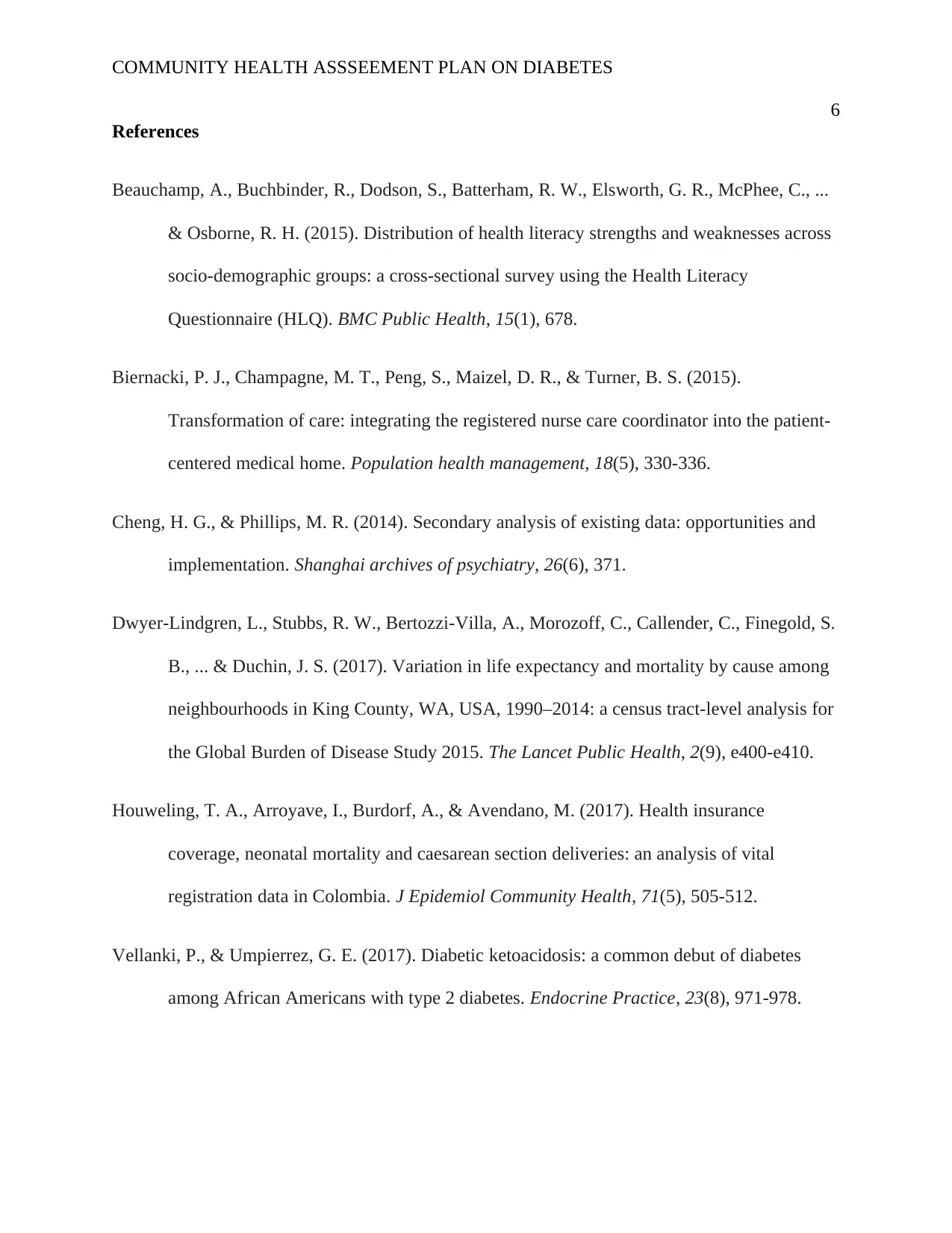
COMMUNITY HEALTH ASSSEEMENT PLAN ON DIABETES
6
References
Beauchamp, A., Buchbinder, R., Dodson, S., Batterham, R. W., Elsworth, G. R., McPhee, C., ...
& Osborne, R. H. (2015). Distribution of health literacy strengths and weaknesses across
socio-demographic groups: a cross-sectional survey using the Health Literacy
Questionnaire (HLQ). BMC Public Health, 15(1), 678.
Biernacki, P. J., Champagne, M. T., Peng, S., Maizel, D. R., & Turner, B. S. (2015).
Transformation of care: integrating the registered nurse care coordinator into the patient-
centered medical home. Population health management, 18(5), 330-336.
Cheng, H. G., & Phillips, M. R. (2014). Secondary analysis of existing data: opportunities and
implementation. Shanghai archives of psychiatry, 26(6), 371.
Dwyer-Lindgren, L., Stubbs, R. W., Bertozzi-Villa, A., Morozoff, C., Callender, C., Finegold, S.
B., ... & Duchin, J. S. (2017). Variation in life expectancy and mortality by cause among
neighbourhoods in King County, WA, USA, 1990–2014: a census tract-level analysis for
the Global Burden of Disease Study 2015. The Lancet Public Health, 2(9), e400-e410.
Houweling, T. A., Arroyave, I., Burdorf, A., & Avendano, M. (2017). Health insurance
coverage, neonatal mortality and caesarean section deliveries: an analysis of vital
registration data in Colombia. J Epidemiol Community Health, 71(5), 505-512.
Vellanki, P., & Umpierrez, G. E. (2017). Diabetic ketoacidosis: a common debut of diabetes
among African Americans with type 2 diabetes. Endocrine Practice, 23(8), 971-978.
6
References
Beauchamp, A., Buchbinder, R., Dodson, S., Batterham, R. W., Elsworth, G. R., McPhee, C., ...
& Osborne, R. H. (2015). Distribution of health literacy strengths and weaknesses across
socio-demographic groups: a cross-sectional survey using the Health Literacy
Questionnaire (HLQ). BMC Public Health, 15(1), 678.
Biernacki, P. J., Champagne, M. T., Peng, S., Maizel, D. R., & Turner, B. S. (2015).
Transformation of care: integrating the registered nurse care coordinator into the patient-
centered medical home. Population health management, 18(5), 330-336.
Cheng, H. G., & Phillips, M. R. (2014). Secondary analysis of existing data: opportunities and
implementation. Shanghai archives of psychiatry, 26(6), 371.
Dwyer-Lindgren, L., Stubbs, R. W., Bertozzi-Villa, A., Morozoff, C., Callender, C., Finegold, S.
B., ... & Duchin, J. S. (2017). Variation in life expectancy and mortality by cause among
neighbourhoods in King County, WA, USA, 1990–2014: a census tract-level analysis for
the Global Burden of Disease Study 2015. The Lancet Public Health, 2(9), e400-e410.
Houweling, T. A., Arroyave, I., Burdorf, A., & Avendano, M. (2017). Health insurance
coverage, neonatal mortality and caesarean section deliveries: an analysis of vital
registration data in Colombia. J Epidemiol Community Health, 71(5), 505-512.
Vellanki, P., & Umpierrez, G. E. (2017). Diabetic ketoacidosis: a common debut of diabetes
among African Americans with type 2 diabetes. Endocrine Practice, 23(8), 971-978.
⊘ This is a preview!⊘
Do you want full access?
Subscribe today to unlock all pages.

Trusted by 1+ million students worldwide
1 out of 6
Related Documents
Your All-in-One AI-Powered Toolkit for Academic Success.
+13062052269
info@desklib.com
Available 24*7 on WhatsApp / Email
![[object Object]](/_next/static/media/star-bottom.7253800d.svg)
Unlock your academic potential
Copyright © 2020–2025 A2Z Services. All Rights Reserved. Developed and managed by ZUCOL.





